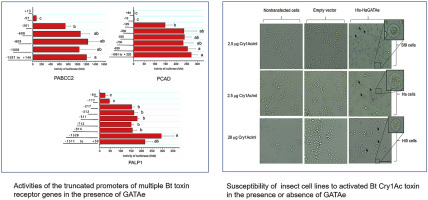当前位置:
X-MOL 学术
›
Insect Biochem. Mol. Biol.
›
论文详情
Our official English website, www.x-mol.net, welcomes your
feedback! (Note: you will need to create a separate account there.)
GATAe transcription factor is involved in Bacillus thuringiensis Cry1Ac toxin receptor gene expression inducing toxin susceptibility.
Insect Biochemistry and Molecular Biology ( IF 3.2 ) Pub Date : 2019-12-13 , DOI: 10.1016/j.ibmb.2019.103306 Wei Wei 1 , Shuang Pan 1 , Yuemin Ma 1 , Yutao Xiao 2 , Yongbo Yang 1 , Sijia He 1 , Alejandra Bravo 3 , Mario Soberón 3 , Kaiyu Liu 1
Insect Biochemistry and Molecular Biology ( IF 3.2 ) Pub Date : 2019-12-13 , DOI: 10.1016/j.ibmb.2019.103306 Wei Wei 1 , Shuang Pan 1 , Yuemin Ma 1 , Yutao Xiao 2 , Yongbo Yang 1 , Sijia He 1 , Alejandra Bravo 3 , Mario Soberón 3 , Kaiyu Liu 1
Affiliation

|
The insecticidal Cry toxins produced by Bacillus thuringiensis (Bt) are powerful tools for insect control. Cry toxin receptors such as cadherin (CAD), ABCC2 transporter and alkaline phosphatase (ALP), located on insect midgut cells, are needed for Cry toxicity. Although insect cell lines are useful experimental models for elucidating toxin action mechanism, most of them show low expression of Cry-receptors genes. The GATA transcription factor family plays important roles in regulating development and differentiation of intestine stem cells. Here, we investigated whether GATAs transcription factors are involved in the expression of Cry1Ac-receptors genes, using multiple insect cell lines. Four GATA genes were identified in the transcriptome of the midgut tissue from the lepidopteran larvae Helicoverpa armigera. These HaGATA genes were transiently expressed in three lepidopteran cell lines, Spodoptera frugiperda Sf9, H. armigera QB-Ha-E5 and Trichoplusia ni Hi5. Analysis of transcription activity using transcriptional gene-fusions showed that only H. armigera GATAe (HaGATAe) significantly increased the transcription of CAD, ABCC2 and ALP receptors genes in all insect cell lines. Key DNA regions for HaGATAe regulation were identified in the promoter sequence of these Cry-receptors genes by using promoter deletion mapping. The transient expression of HaGATAe in these cell lines, conferred sensitivity to Cry1Ac toxin, although in Hi5 cells the susceptibility to Cry1Ac was lower than in other two cell lines. High sensitivity to Cry1Ac correlated with simultaneous transcription of ABCC2 and CAD genes in Sf9 and QB-Ha-E5 cells. Our results reveal that HaGATAe enhances transcription of several lepidopteran Cry1Ac receptor genes in cultured insect cells.
中文翻译:

GATAe转录因子参与苏云金芽孢杆菌Cry1Ac毒素受体基因表达诱导毒素敏感性。
苏云金芽孢杆菌(Btillus thuringiensis)(Bt)产生的杀虫Cry毒素是控制昆虫的有力工具。Cry毒性需要位于昆虫中肠细胞上的Cry毒素受体,例如钙黏着蛋白(CAD),ABCC2转运蛋白和碱性磷酸酶(ALP)。尽管昆虫细胞系是阐明毒素作用机制的有用实验模型,但大多数昆虫细胞显示出Cry受体基因的低表达。GATA转录因子家族在调节肠干细胞的发育和分化中起重要作用。在这里,我们使用多种昆虫细胞系调查了GATAs转录因子是否参与Cry1Ac受体基因的表达。在鳞翅目幼虫Helicoverpa armigera的中肠组织的转录组中鉴定出四个GATA基因。这些HaGATA基因在三种鳞翅类细胞系中,鳞翅目Sf9,棉铃虫QB-Ha-E5和Trichoplusia ni Hi5瞬时表达。使用转录基因融合分析转录活性表明,只有棉铃虫GATAe(HaGATAe)才能显着增加所有昆虫细胞系中CAD,ABCC2和ALP受体基因的转录。通过使用启动子缺失作图,在这些Cry-受体基因的启动子序列中鉴定出用于HaGATAe调控的关键DNA区域。HaGATAe在这些细胞系中的瞬时表达赋予了对Cry1Ac毒素的敏感性,尽管在Hi5细胞中对Cry1Ac的敏感性低于其他两个细胞系。对Cry1Ac的高敏感性与Sf9和QB-Ha-E5细胞中ABCC2和CAD基因的同时转录有关。
更新日期:2019-12-13
中文翻译:

GATAe转录因子参与苏云金芽孢杆菌Cry1Ac毒素受体基因表达诱导毒素敏感性。
苏云金芽孢杆菌(Btillus thuringiensis)(Bt)产生的杀虫Cry毒素是控制昆虫的有力工具。Cry毒性需要位于昆虫中肠细胞上的Cry毒素受体,例如钙黏着蛋白(CAD),ABCC2转运蛋白和碱性磷酸酶(ALP)。尽管昆虫细胞系是阐明毒素作用机制的有用实验模型,但大多数昆虫细胞显示出Cry受体基因的低表达。GATA转录因子家族在调节肠干细胞的发育和分化中起重要作用。在这里,我们使用多种昆虫细胞系调查了GATAs转录因子是否参与Cry1Ac受体基因的表达。在鳞翅目幼虫Helicoverpa armigera的中肠组织的转录组中鉴定出四个GATA基因。这些HaGATA基因在三种鳞翅类细胞系中,鳞翅目Sf9,棉铃虫QB-Ha-E5和Trichoplusia ni Hi5瞬时表达。使用转录基因融合分析转录活性表明,只有棉铃虫GATAe(HaGATAe)才能显着增加所有昆虫细胞系中CAD,ABCC2和ALP受体基因的转录。通过使用启动子缺失作图,在这些Cry-受体基因的启动子序列中鉴定出用于HaGATAe调控的关键DNA区域。HaGATAe在这些细胞系中的瞬时表达赋予了对Cry1Ac毒素的敏感性,尽管在Hi5细胞中对Cry1Ac的敏感性低于其他两个细胞系。对Cry1Ac的高敏感性与Sf9和QB-Ha-E5细胞中ABCC2和CAD基因的同时转录有关。











































 京公网安备 11010802027423号
京公网安备 11010802027423号